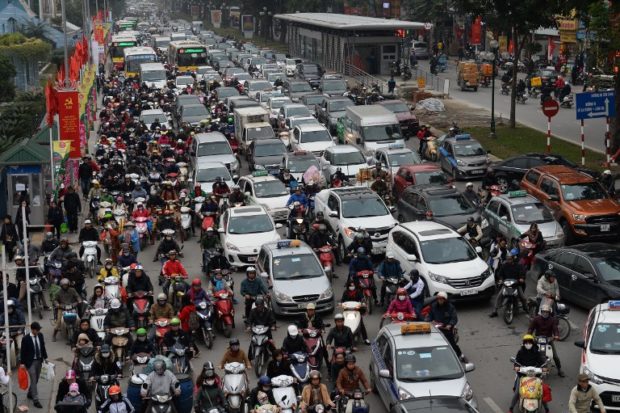Annual cost of Hanoi traffic reaches $1.2 billion

Motorbikes try to weave their way between the cars as they all fight for space on the road as heavy traffic clogs up a main street in downtown Hanoi on January 29, 2016. AFP FILE PHOTO
HANOI — Traffic congestion has cost Hanoi between US$1 and 1.2 billion per year and has made air pollution five times worse, the Institute for Transportation and Development Policy under the Ministry of Transport said.
Speaking at a seminar on reducing traffic congestion and air pollution in Hanoi last week, director of the institute’s Urban and Rural Traffic Center Pham Hoai Chung said in addition to the economic loss, the city’s air pollution index has risen five times higher than allowed levels.
Traffic congestion has caused the loss of more than one million working hours per year, he said.
According to Chung, the congestion is caused by the excessive population density of the inner city, and by the gap between the growth rate of vehicles and work on traffic infrastructure.
Hanoi has about 5.5 million motorbikes and nearly 500,000 cars. From 2010 to 2017, the number of cars and motorbikes increased by 10 per cent and 8 per cent per year respectively while new roads only increased infrastructure by 0.39 per cent per year.
Lieutenant Colonel Nguyen Manh Hung, deputy head of the Traffic Police Department of the Hanoi Police Department, said the city’s infrastructure has not been good enough to meet transport needs. Many roads carry up to seven times the number of cars and motorbikes they were designed to accommodate.
Vietnam has used only 8.65 percent of its land fund for infrastructure projects, but the law stipulates that the portion of land fund used for urban traffic should be between 16 and 26 per cent.
In many developed countries, the percentage was between 20 and 25. Hung said this means overloading is unavoidable.
He said the high density of apartment buildings worsens overcrowding on roadways.
To reduce traffic jams, deputy director of the city’s Department of Transport Ngo Manh Tuan said the city had a specific plan for traffic infrastructure development from 2010 to 2020.
The city has implemented projects on ring roads one, two and three, and has invested in the construction of radial roads in order to gradually improve traffic infrastructure.
To ensure traffic safety, the Department of Transport was asked to improve infrastructure enough so that the city has no traffic jams by 2030.
In the first phase from 2017 to 2018, the city is focusing on tightening transportation management. From 2017 to 2030, the city will restrict the number of vehicles in some inner areas and ban motorbikes in some central districts starting in 2030, he said.